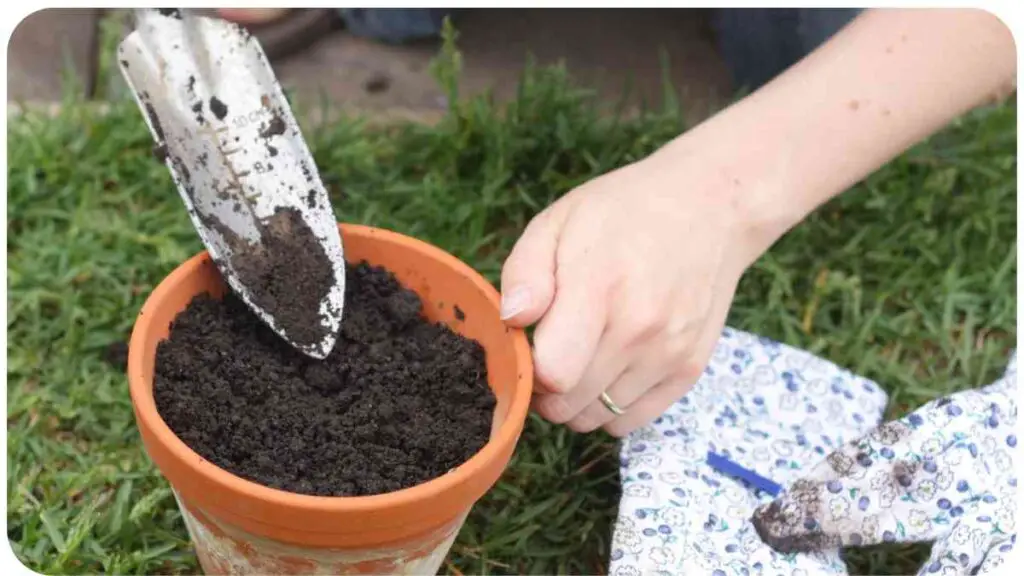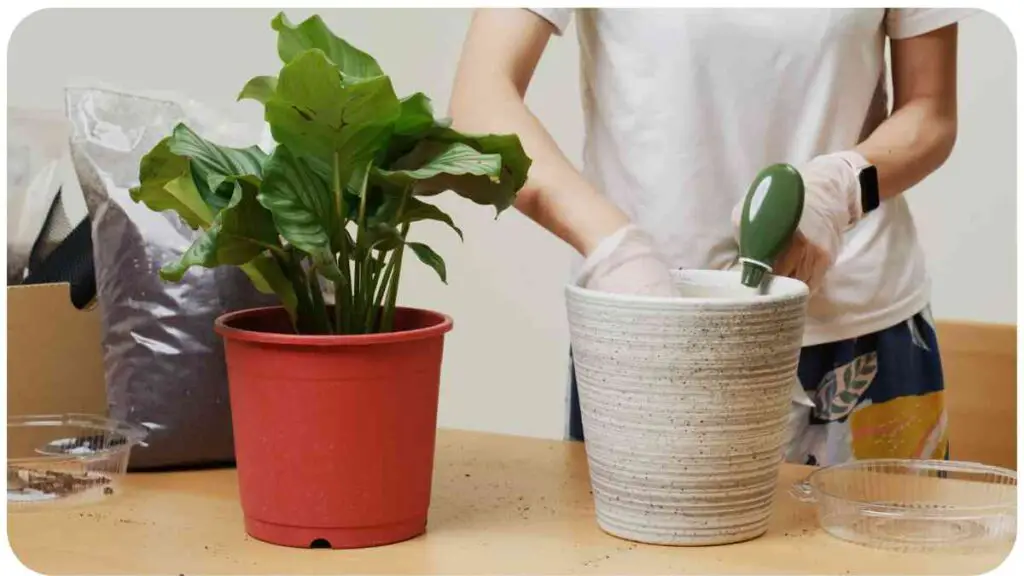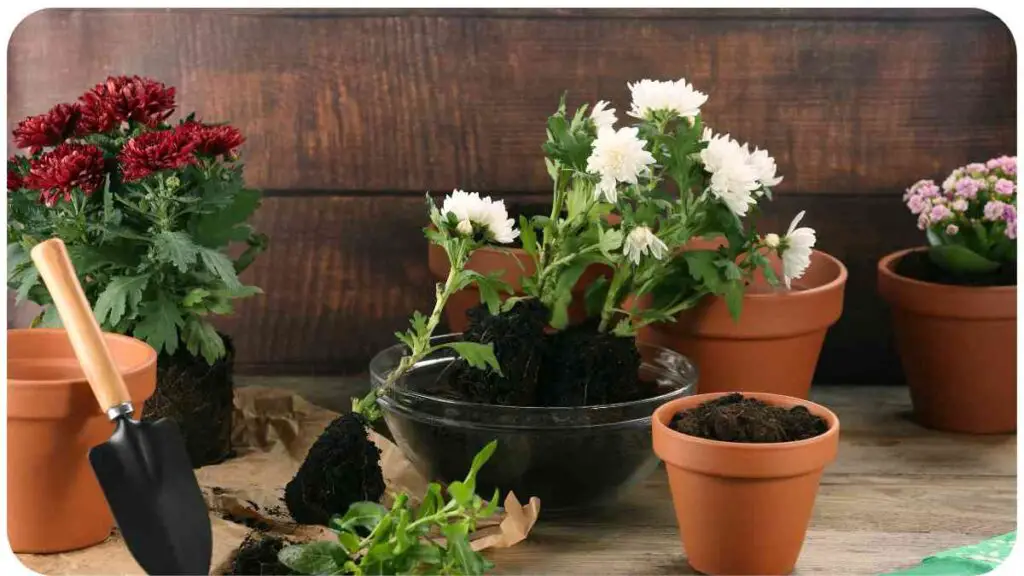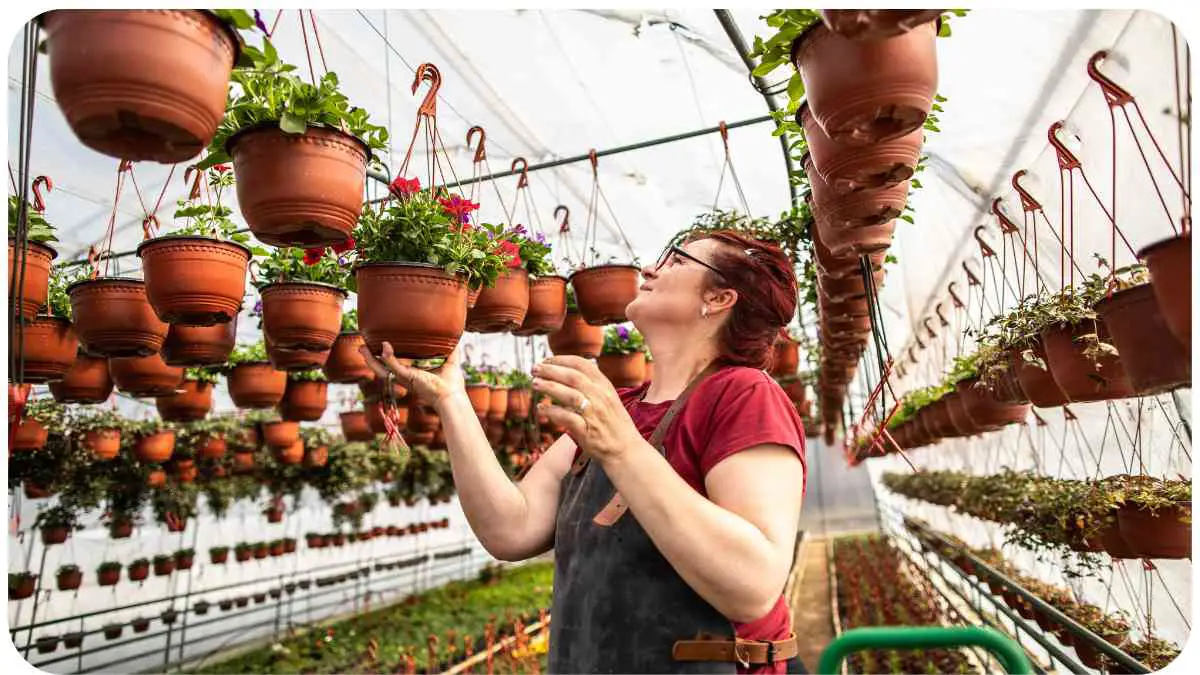When it comes to successful gardening, the quality of your potting soil plays a crucial role in the health and vitality of your plants. However, determining when to change your potting soil can be a bit tricky.
In this comprehensive guide, we’ll explore the signs indicating it’s time for a soil change, understand the composition of potting soil, discuss factors influencing its lifespan, and provide practical tips for extending its longevity.
| Takeaways |
|---|
| Regularly changing potting soil is essential for maintaining healthy plants. |
| Signs indicating it’s time to change potting soil include foul odor, poor drainage, compacted soil, and visible mold or fungus. |
| Proper soil management practices, such as watering, mulching, and fertilizing, can extend the lifespan of potting soil and promote plant health. |
| Sustainable gardening practices, like reducing waste, choosing eco-friendly amendments, and conserving water, contribute to a healthier garden ecosystem and planet. |
| Listening to your plants, observing their growth, and following expert guidelines ensure successful potting soil management and thriving plants. |
2. Signs It’s Time to Change Your Potting Soil
| Signs | Description |
|---|---|
| Foul Odor | A strong, unpleasant smell emanating from the soil indicates microbial activity or decay. |
| Poor Drainage | Excessively wet soil that fails to drain properly can lead to root rot and other issues. |
| Compacted Soil | Soil that has become compacted over time hinders root growth and nutrient absorption. |
| Visible Mold or Fungus | Presence of mold or fungus on the soil surface signifies poor air circulation or excess moisture. |
3. Understanding Potting Soil Composition

Potting soil is a blend of various organic and inorganic materials designed to support plant growth in containers. Common ingredients include peat moss, perlite, vermiculite, compost, and sand. Each component serves a specific purpose, such as retaining moisture, improving drainage, or providing essential nutrients. Understanding the composition of your potting soil is crucial for determining its lifespan and when it needs to be changed.
Knowing how often to replace your potting soil is crucial for maintaining healthy plants. Regular replacement ensures optimal nutrient levels and prevents soil compaction, fostering robust growth.
4. Factors Influencing Potting Soil Lifespan
| Factors | Impact on Soil Lifespan |
|---|---|
| Plant Type and Size | Different plants have varying nutrient requirements and root structures, influencing soil depletion rates. |
| Container Size and Material | Larger containers retain moisture for longer periods, while certain materials may leach nutrients from the soil. |
| Environmental Conditions | Exposure to sunlight, temperature fluctuations, and humidity levels affect soil decomposition and microbial activity. |
| Watering Practices | Overwatering can lead to soil compaction and nutrient leaching, accelerating the need for soil replacement. |
5. Frequency of Soil Changes for Different Plants
Different types of plants have unique requirements and growth patterns, affecting the frequency at which you should change their potting soil. Here’s a general guideline for some common plant categories:
Houseplants
Houseplants typically benefit from annual soil changes to replenish nutrients and maintain soil structure. However, certain fast-growing species may require more frequent soil refreshments every 6 to 8 months.
Succulents and Cacti
Succulents and cacti thrive in well-draining soil and are more resistant to soil depletion. You can usually go 2 to 3 years before needing to change their potting mix.
Estimating the amount of potting soil needed for a 30-gallon pot ensures proper filling without wastage or shortage. Adequate soil volume promotes root development and supports plant stability and vitality.
Annual Flowers and Vegetables
Annual flowers and vegetables are heavy feeders and may require soil amendments or replacement each growing season to support robust growth and fruit production.
Perennial Plants
Perennial plants establish deeper root systems over time and may only need soil changes every 2 to 3 years, depending on their specific needs and container size.
Orchids
Orchids have unique growing requirements and often benefit from specialized orchid mixtures. Repotting every 1 to 2 years, or when the potting medium breaks down, is recommended.
6. How to Properly Change Potting Soil

Changing potting soil may seem like a daunting task, but with the right approach, it can be a straightforward process. Follow these steps to ensure a successful soil change:
Step 1: Select the Right Time
Choose a time when your plant is not actively growing or flowering to minimize stress. Early spring or late winter is often ideal for most plants.
Step 2: Prepare Your Workspace
Gather all necessary materials, including new potting soil, a larger container if needed, and any tools for repotting. Lay down newspaper or a drop cloth to catch soil and debris.
Identifying signs of bad potting mix is essential for preventing plant health issues. Recognizing indicators like foul odors or mold growth prompts timely soil replacement, preserving plant vigor and vitality.
Step 3: Remove the Plant from its Container
Gently tip the plant on its side and slide it out of the pot. If the plant is root-bound, carefully loosen the roots with your fingers or a tool to encourage healthy growth.
Step 4: Inspect the Roots
Check the roots for signs of damage, rot, or pests. Trim away any dead or diseased roots with sterile scissors or pruning shears.
Step 5: Dispose of Old Soil
Empty the old potting soil into a container or compost bin. Avoid reusing old soil to prevent the spread of diseases or pests.
Step 6: Prepare the New Potting Soil
Mix the new potting soil with organic matter such as compost or aged manure to improve its nutrient content and structure.
Mastering the process of replacing potting soil is key to maintaining optimal growing conditions. Proper techniques minimize plant stress and ensure seamless transitions, fostering continuous growth and vitality.
Step 7: Repot the Plant
Place a layer of fresh soil in the bottom of the new container, then position the plant in the center. Fill in around the roots with additional soil, gently firming it down as you go.
Step 8: Water Thoroughly
After repotting, water the plant thoroughly to help settle the soil and hydrate the roots. Allow any excess water to drain away before returning the plant to its usual location.
Step 9: Monitor and Maintain
Keep an eye on your plant in the following weeks to ensure it adjusts well to its new soil. Adjust watering and fertilizing as needed to support healthy growth.
7. Types of Potting Soil and Their Longevity
The type of potting soil you use can also influence how often you need to change it. Here are some common types of potting soil and their typical lifespan:
Standard Potting Mix
Standard potting mixes, composed of peat moss, perlite, and vermiculite, usually last for about one to two years before needing replacement. Over time, these organic components break down and lose their ability to retain moisture and nutrients.
Organic Potting Soil
Organic potting soils, enriched with compost and other natural additives, tend to have a shorter lifespan compared to standard mixes. Expect to replace organic soil every 6 to 12 months to maintain optimal plant health and vigor.
Specialty Mixes
Specialty potting mixes, such as those designed for orchids, cacti, or succulents, often contain unique blends of ingredients tailored to specific plant needs. While these mixes may last longer than standard soil, it’s still essential to monitor their condition regularly and refresh them as necessary.
DIY Mixes
Some gardeners prefer to create their own potting soil blends using a combination of ingredients like garden soil, compost, sand, and perlite. DIY mixes can be customized to suit individual plant preferences and may require more frequent adjustments based on plant performance and nutrient requirements.
8. Benefits of Regularly Changing Potting Soil

Regularly changing your potting soil offers several benefits that contribute to the overall health and vitality of your plants:
Learning how to regenerate old potting soil extends its usefulness and reduces waste. Techniques like amending with compost or aerating rejuvenate soil structure, promoting nutrient availability and sustaining plant health over time.
1. Improved Nutrient Availability
Fresh potting soil contains a balanced mix of essential nutrients necessary for plant growth. By replacing depleted soil, you ensure that your plants have access to the nutrients they need to thrive.
2. Enhanced Drainage and Aeration
Over time, potting soil can become compacted, leading to poor drainage and limited air circulation around the roots. Changing the soil allows you to maintain optimal soil structure, promoting healthy root development and preventing waterlogged conditions.
3. Reduction of Soil-Borne Diseases and Pests
Old potting soil may harbor harmful pathogens, pests, or weed seeds that can negatively impact plant health. By starting with fresh soil, you reduce the risk of disease outbreaks and pest infestations, creating a healthier growing environment for your plants.
4. Prevention of Nutrient Imbalances
Continuous watering and fertilizing can result in nutrient imbalances or salt buildup in the soil, affecting plant growth and overall performance. Changing the soil periodically helps reset nutrient levels and prevent potential toxicity issues.
5. Revitalization of Potting Mix
Refreshing your potting soil rejuvenates its texture and structure, making it more conducive to root growth and nutrient uptake. Plants grown in revitalized soil are likely to exhibit improved vigor, vitality, and flowering capacity.
6. Enhanced Plant Growth and Flowering
Healthy soil provides a solid foundation for robust plant growth and abundant flowering. By changing the soil regularly, you create optimal conditions for your plants to thrive, resulting in lush foliage and vibrant blooms.
9. Common Mistakes to Avoid When Changing Potting Soil
While changing potting soil is a beneficial practice, it’s essential to avoid common mistakes that could hinder your plant’s health and growth:
1. Using Poor-Quality Soil
Choosing low-quality or contaminated potting soil can introduce pests, diseases, or weed seeds into your garden. Always opt for reputable brands or prepare your own soil mix using high-quality ingredients.
2. Neglecting Root Inspection
Failing to inspect the plant’s roots before repotting can lead to transplanting issues or exacerbate existing root problems. Take the time to examine the roots for signs of damage, rot, or overcrowding before proceeding with the soil change.
3. Reusing Old Soil
Reusing old potting soil without proper sterilization or rejuvenation can reintroduce pests, diseases, or nutrient deficiencies into your garden. Dispose of old soil or compost it properly to prevent contamination.
4. Overwatering After Repotting
Watering plants excessively immediately after repotting can lead to waterlogged soil conditions and root rot. Allow the plant to adjust to its new soil before resuming regular watering, and always water according to the plant’s specific needs.
5. Failing to Gradually Transition Plants
Abruptly moving plants to new soil or larger containers without acclimatizing them first can cause transplant shock and stress. Gradually introduce plants to their new environment by transitioning them over several days or weeks.
6. Ignoring Soil Amendments
Neglecting to amend or fertilize the new potting soil can result in nutrient deficiencies over time. Incorporate organic matter, slow-release fertilizers, or compost into the soil to replenish nutrients and support plant growth.
7. Packing Soil Too Tightly
Compacting the soil too tightly around the plant’s roots can restrict root growth and hinder nutrient uptake. Gently firm the soil without compacting it excessively to ensure proper aeration and drainage.
8. Neglecting Regular Maintenance
Changing potting soil is just one aspect of plant care; regular maintenance is essential for long-term health and vitality. Monitor soil moisture, inspect for pests or diseases, and adjust watering and fertilizing as needed to support optimal plant growth.
By avoiding these common pitfalls, you can ensure a successful soil change and promote the health and vigor of your plants.
10. Cost Considerations and Budget-Friendly Options
When it comes to changing potting soil, cost considerations are an important factor to keep in mind. Fortunately, there are several budget-friendly options and strategies you can explore:
1. Bulk Purchases
Buying potting soil in bulk quantities can often result in significant cost savings compared to purchasing smaller bags. Look for local garden centers or suppliers that offer bulk discounts or consider splitting a large bag with friends or neighbors.
2. DIY Soil Mixes
Creating your own potting soil blends using inexpensive ingredients like garden soil, compost, and perlite can be more cost-effective than buying pre-made mixes. Experiment with different ratios to find a blend that suits your plants’ needs and your budget.
3. Soil Amendments
Instead of completely replacing your potting soil, consider adding soil amendments like compost, aged manure, or organic fertilizers to rejuvenate existing soil. Amendments can help replenish nutrients, improve soil structure, and extend the lifespan of your potting mix.
4. Container Recycling
Reuse old containers or repurpose items like buckets, crates, or even old tires as planters to save money on new pots. Just be sure to clean and sterilize containers before replanting to prevent disease spread.
5. Vermicomposting
Start a vermicomposting system to produce nutrient-rich compost for your potting soil. Worm castings are a valuable organic fertilizer and soil conditioner that can be incorporated into your soil mix to enhance plant growth and health.
6. Plant Propagation
Save money on new plants by propagating your existing ones through methods like stem cuttings, division, or leaf cuttings. Propagation allows you to expand your plant collection without the need to purchase additional potting soil or containers.
7. Community Resources
Explore community gardens, gardening clubs, or online forums where members may share surplus potting soil, plants, or gardening supplies. Participating in community gardening initiatives can not only save money but also foster connections with fellow gardeners.
By implementing these cost-saving strategies and exploring budget-friendly options, you can change your potting soil without breaking the bank.
11. Expert Tips for Extending Potting Soil Lifespan
Maximizing the lifespan of your potting soil requires careful attention to soil management practices and gardening techniques. Here are some expert tips to help you extend the longevity of your potting soil:
1. Practice Proper Watering
Avoid overwatering your plants, as excessive moisture can lead to soil compaction, root rot, and nutrient leaching. Water your plants only when the top inch of soil feels dry to the touch, and use containers with drainage holes to prevent waterlogging.
2. Mulch the Soil Surface
Apply a layer of organic mulch, such as shredded leaves, straw, or bark chips, to the soil surface to help retain moisture, suppress weeds, and regulate soil temperature. Mulching also encourages beneficial microbial activity and improves soil structure over time.
3. Rotate Plants Regularly
Rotate your potted plants periodically to promote even root growth and prevent soil depletion in specific areas of the container. Rotating plants also helps prevent the buildup of pests and diseases associated with stagnant soil conditions.
4. Use Slow-Release Fertilizers
Incorporate slow-release fertilizers into your potting soil to provide a steady supply of nutrients to your plants over an extended period. Slow-release fertilizers reduce the risk of nutrient imbalances and minimize the need for frequent soil amendments.
5. Monitor Soil pH Levels
Regularly test the pH levels of your potting soil to ensure it remains within the optimal range for plant growth. Most plants prefer slightly acidic to neutral soil conditions, so adjust the pH as needed using organic amendments like lime or sulfur.
6. Implement Crop Rotation
If growing vegetables or annual flowers in containers, practice crop rotation to prevent soil depletion and nutrient imbalances. Rotate crops each growing season to avoid planting the same species in the same soil for consecutive years.
7. Incorporate Cover Crops
Consider planting cover crops like clover, vetch, or winter rye in your containers during periods of inactivity to improve soil fertility, prevent erosion, and suppress weeds. Cover crops also add organic matter to the soil when tilled under, enhancing its structure and nutrient content.
By implementing these expert tips, you can prolong the lifespan of your potting soil and create a healthier growing environment for your plants.
12. Sustainability Practices in Potting Soil Management
Promoting sustainability in potting soil management involves adopting eco-friendly practices that minimize waste, conserve resources, and support environmental health. Here are some sustainable practices to consider:
1. Reduce, Reuse, Recycle
Minimize waste by reusing containers, pots, and trays whenever possible. Repurpose old containers or explore options for recycling plastic pots to divert them from landfills. Additionally, consider composting organic plant debris and kitchen scraps to create nutrient-rich compost for your potting soil.
2. Choose Sustainable Soil Amendments
Opt for organic soil amendments and fertilizers derived from renewable sources, such as compost, aged manure, or worm castings. These natural amendments improve soil fertility, structure, and microbial activity without relying on synthetic chemicals or fossil fuels.
3. Practice Water Conservation
Conserve water by incorporating water-saving techniques into your gardening routine, such as using drip irrigation systems, mulching the soil surface, and collecting rainwater in barrels for irrigation. Efficient water management reduces water waste and promotes the sustainable use of this vital resource.
4. Support Local and Organic Suppliers
Source potting soil and gardening supplies from local or organic suppliers whenever possible to reduce carbon emissions associated with transportation and support sustainable agricultural practices. Choose products certified by reputable organizations like the Organic Materials Review Institute (OMRI) to ensure they meet organic standards.
5. Embrace No-Till Gardening
Implement no-till gardening techniques to minimize soil disturbance, preserve soil structure, and sequester carbon in the soil. Avoiding tillage reduces erosion, enhances soil fertility, and promotes beneficial soil organisms, making it a sustainable approach to potting soil management.
6. Promote Biodiversity
Encourage biodiversity in your garden by planting a diverse range of plant species, including native plants and pollinator-friendly flowers. Biodiverse gardens support healthy ecosystems, attract beneficial insects, and enhance soil health through natural processes like nutrient cycling and pest control.
7. Educate and Advocate
Share your knowledge of sustainable gardening practices with others and advocate for policies that promote environmental stewardship and conservation. Participate in community gardening initiatives, workshops, and outreach programs to inspire others to adopt sustainable potting soil management practices.
By embracing these sustainability practices, you can contribute to the health of the planet while enjoying the rewards of a thriving garden.
13. Conclusion
Knowing when to change your potting soil is essential for maintaining healthy and thriving plants in your garden or indoor space. By recognizing the signs indicating soil depletion, understanding the factors influencing soil lifespan, and implementing proper soil management practices, you can ensure optimal growing conditions for your plants.
Regularly changing potting soil offers numerous benefits, including improved nutrient availability, enhanced drainage and aeration, and reduced risks of soil-borne diseases and pests. By avoiding common mistakes, exploring cost-effective options, and incorporating expert tips, you can extend the lifespan of your potting soil and promote sustainable gardening practices.
Furthermore, by adopting sustainability practices in potting soil management, such as reducing waste, choosing eco-friendly amendments, conserving water, and supporting biodiversity, you can minimize your environmental footprint and contribute to a healthier planet.
Remember, gardening is not only about nurturing plants but also about fostering a deeper connection with nature and promoting ecological balance. By caring for your potting soil with diligence and consideration, you can create a thriving garden ecosystem that brings joy, beauty, and sustenance to your life and the world around you.
Further Reading
- The Sill – Plant Care: When and How to Repot Plants
- Explore expert tips on when and how to repot your plants for optimal growth and health.
- Martha Stewart – How Often Should You Change the Soil for Houseplants?
- Learn about the frequency of changing soil for houseplants and best practices for maintaining healthy indoor greenery.
- Davey Tree – How to Refresh Potted Plants by Changing Soil
- Discover step-by-step instructions for refreshing potted plants through soil changes, ensuring continued vitality and vigor.
FAQs
How often should I change my potting soil?
Regularly changing potting soil is beneficial for plant health, typically every 1 to 2 years, depending on various factors such as plant type, container size, and environmental conditions.
What are the signs that indicate it’s time to change potting soil?
Signs such as foul odor, poor drainage, compacted soil, and visible mold or fungus indicate that it’s time to change potting soil to maintain optimal growing conditions for your plants.
Can I reuse old potting soil?
While it’s possible to reuse old potting soil, it’s essential to sterilize or rejuvenate it properly to prevent the spread of diseases, pests, or nutrient deficiencies. Adding compost or organic matter can help revitalize old soil for reuse.
How can I extend the lifespan of my potting soil?
You can extend the lifespan of your potting soil by practicing proper watering, mulching the soil surface, rotating plants regularly, using slow-release fertilizers, monitoring soil pH levels, and promoting biodiversity in your garden.
Are there sustainable practices for potting soil management?
Yes, promoting sustainability in potting soil management involves reducing waste, choosing sustainable soil amendments, conserving water, supporting local and organic suppliers, embracing no-till gardening, and promoting biodiversity in your garden ecosystem.

For 15 years, Hellen James has worked in the gardening industry as an expert and landscape designer. During her career, she has worked for a variety of businesses that specialize in landscaping and gardening from small firms to large corporations.

